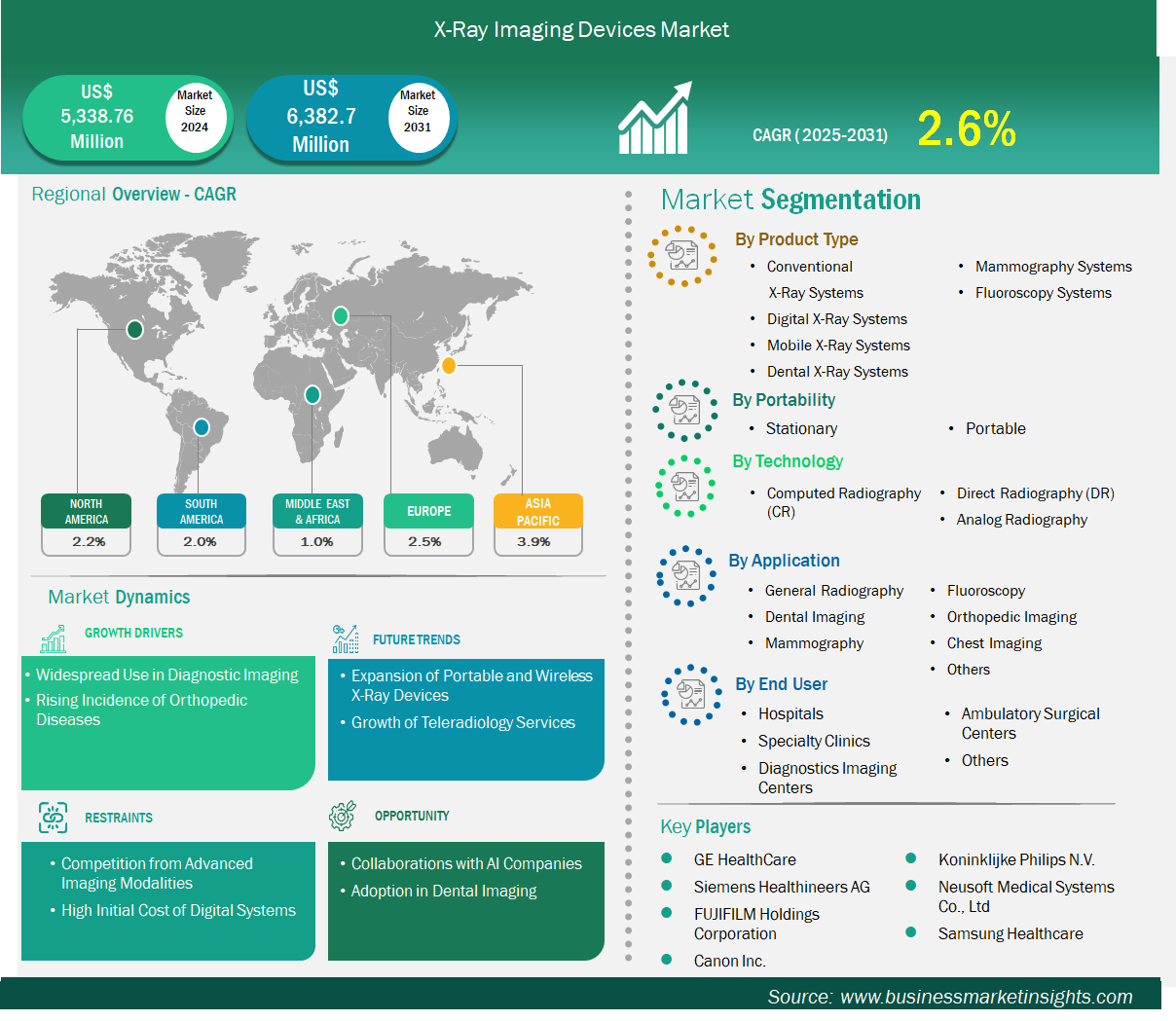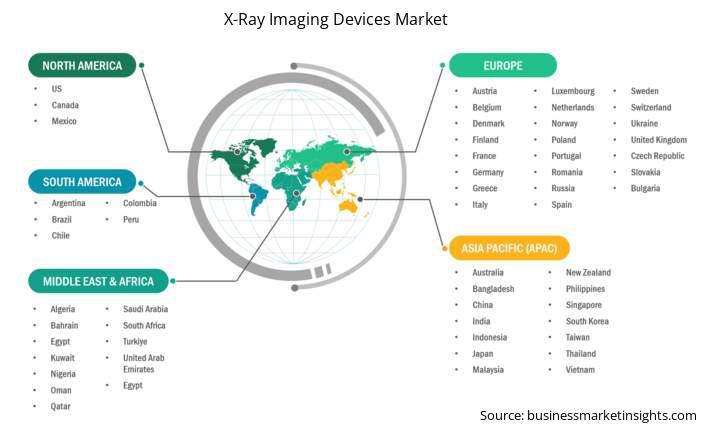X-Ray Imaging Devices Market Outlook (2021-2031)
No. of Pages: 200 | Report Code: BMIPUB00031638 | Category: Life Sciences
No. of Pages: 200 | Report Code: BMIPUB00031638 | Category: Life Sciences
The X-Ray Imaging Devices market size is expected to reach US$ 6,382.70 million by 2031 from US$ 5,338.76 million in 2024. The market is estimated to record a CAGR of 2.6% from 2025 to 2031.
Executive Summary and Global Market Analysis:
The X-ray imaging devices market is evolving steadily, supported by its fundamental role in primary diagnostics and its adaptability across various clinical settings. With the increasing burden of trauma injuries, dental disorders, and chronic skeletal conditions, X-ray remains a first-line diagnostic tool due to its speed, simplicity, and low cost. The shift toward value-based healthcare is encouraging the adoption of more efficient digital radiography systems that offer better image quality and faster turnaround times. The demand for point-of-care and mobile imaging is also rising, particularly in emergency care and during global health crises.
In line with the adoption rate, the global X-ray imaging devices market stood at US$ 5,338.76 million in 2024 and is expected to reach US$ 6,382.70 million by 2031.Furthermore, X-rays are critical in dental, pediatric, and postoperative imaging, expanding their use beyond traditional radiology departments. While radiation safety remains a concern, ongoing advancements in image processing and shielding techniques are helping mitigate risks, keeping X-ray imaging highly relevant in modern diagnostics.
X-Ray Imaging Devices Market Strategic Insights

X-Ray Imaging Devices Market Segmentation Analysis
Key segments that contributed to the derivation of the X-ray imaging devices market analysis are product type, portability, technology, application, and end user.
X-Ray Imaging Devices Market Drivers and Opportunities:
Widespread Use in Diagnostic Imaging
X-ray imaging continues to be one of the most commonly used diagnostic tools in healthcare due to its speed, affordability, and versatility. It is often the first-line imaging technique used in a wide range of clinical settings, from emergency rooms and outpatient clinics to dental practices and rural healthcare centers. X-rays provide quick visualization of bones, lungs, and certain soft tissues, enabling physicians to make rapid and accurate assessments. The availability of both conventional and digital systems ensures flexibility in adoption across various economic and infrastructural environments. Moreover, advancements in image clarity, digital storage, and integration with hospital information systems have significantly improved workflow efficiency. This widespread utility across medical specialties—including orthopedics, dentistry, pulmonology, and cardiology—ensures that X-ray imaging remains indispensable in both routine check-ups and acute diagnostic scenarios, driving continued demand in the market.
Rising Incidence of Orthopedic Diseases
The increasing global incidence of orthopedic diseases and injuries is a key driver of growth in the X-ray imaging devices market. Conditions such as arthritis, osteoporosis, fractures, and sports-related injuries are becoming more prevalent due to aging populations, sedentary lifestyles, and a rise in physically demanding activities. X-ray is the primary imaging method used to assess bone integrity, joint health, and skeletal abnormalities, making it essential in both diagnosis and treatment planning. Orthopedic specialists rely on X-ray imaging for everything from identifying minor fractures to evaluating post-surgical recovery and implant positioning. The growing demand for orthopedic care—especially in aging societies and regions with high rates of road accidents or occupational hazards—is translating into increased use of X-ray systems. This sustained clinical need continues to fuel the adoption of both fixed and portable X-ray technologies in hospitals and specialty clinics.
X-Ray Imaging Devices Market Size and Share Analysis
By product type, the X-ray imaging devices market is segmented into conventional X-ray systems, digital X-ray systems, mobile X-ray systems, dental X-ray systems, mammography systems, and fluoroscopy systems. The digital X-ray systems segment dominated the market in 2024. Digital systems dominate due to faster imaging, superior image quality, lower radiation exposure, and seamless integration with hospital IT systems for efficient diagnostics and workflow management.
By portability, the X-ray imaging devices market is segmented into stationary and portable. Stationary segment dominated the market in 2024. Stationary X-ray systems are the backbone of imaging departments, providing higher throughput, better image quality, and compatibility with advanced imaging technologies for diverse clinical needs.
By technology, the X-ray imaging devices market is segmented into computed radiography, direct radiography, and analog radiography. Direct radiography segment dominated the market in 2024. Direct radiography systems are preferred for their real-time image acquisition, minimal processing time, high image clarity, and reduced repeat scans, leading to faster and more accurate diagnostics.
By application, the X-ray imaging devices market is segmented into general radiography, dental imaging, mammography, fluoroscopy, orthopedic imaging, chest imaging and others. The general radiography segment dominated the market in 2024. General radiography includes chest, abdomen, skeletal, and trauma imaging, making it the most commonly performed and essential X-ray application across hospitals and outpatient settings. Organization orthopedic
By end user, the market is segmented into hospitals, specialty clinics, diagnostics imaging centers, ambulatory surgical centers and others. The hospitals segment held the largest share of the market in 2024. Hospitals represent the leading end users in the X-ray imaging devices market due to their extensive infrastructure, skilled personnel, and ability to handle high patient volumes.
| Report Attribute | Details |
|---|---|
| Market size in 2024 | US$ 5,338.76 Million |
| Market Size by 2031 | US$ 6,382.7 Million |
| Global CAGR (2025 - 2031) | 2.6% |
| Historical Data | 2021-2023 |
| Forecast period | 2025-2031 |
| Segments Covered |
By Product Type
|
| Regions and Countries Covered | North America
|
| Market leaders and key company profiles |
|
The "X-Ray Imaging Devices Market Size and Forecast (2021–2031)" report provides a detailed analysis of the market covering below areas:

The geographical scope of the X-ray imaging devices market report is divided into five regions: North America, Asia Pacific, Europe, Middle East & Africa, and South & Central America. The X-ray imaging devices market in Asia Pacific is expected to grow significantly during the forecast period.
The Asia Pacific X-ray imaging devices market is segmented into China, Japan, South Korea, India, Australia, New Zealand, Indonesia, Malaysia, Philippines, Singapore, Thailand, Vietnam, Taiwan, Bangladesh and Rest of Asia. The X-ray imaging devices market in the Asia Pacific region is witnessing strong growth due to rising healthcare awareness, increasing government investment, and expanding access to diagnostic services. Rapid urbanization and a growing middle-class population are driving demand for affordable, non-invasive imaging, especially in maternal health, cardiology, and general diagnostics. Portable and handheld X-ray imaging devices are gaining popularity in rural and underserved areas, supported by initiatives to strengthen primary healthcare systems. Additionally, the region is seeing increased adoption of point-of-care X-ray imaging devices in emergency and critical care settings. Local manufacturing, coupled with rising investments in AI-based imaging technologies, is further fuelling market expansion. However, uneven distribution of healthcare infrastructure and shortage of trained professionals in some areas remain key challenges to wider adoption.
X-Ray Imaging Devices Market News and Key Development:
The X-ray imaging devices market is evaluated by gathering qualitative and quantitative data post primary and secondary research, which includes important corporate publications, association data, and databases. A few of the key developments in the X-ray imaging devices market are:
Key Sources Referred:
The X-Ray Imaging Devices Market is valued at US$ 5,338.76 Million in 2024, it is projected to reach US$ 6,382.7 Million by 2031.
As per our report X-Ray Imaging Devices Market, the market size is valued at US$ 5,338.76 Million in 2024, projecting it to reach US$ 6,382.7 Million by 2031. This translates to a CAGR of approximately 2.6% during the forecast period.
The X-Ray Imaging Devices Market report typically cover these key segments-
The historic period, base year, and forecast period can vary slightly depending on the specific market research report. However, for the X-Ray Imaging Devices Market report:
The X-Ray Imaging Devices Market is populated by several key players, each contributing to its growth and innovation. Some of the major players include:
The X-Ray Imaging Devices Market report is valuable for diverse stakeholders, including:
Essentially, anyone involved in or considering involvement in the X-Ray Imaging Devices Market value chain can benefit from the information contained in a comprehensive market report.